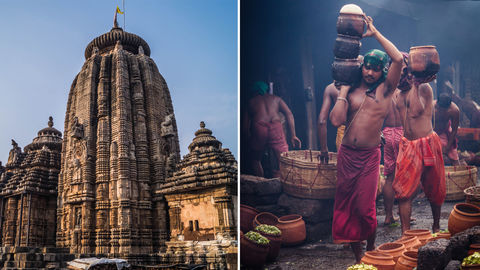
In the corridors of Bhubaneswar’s Ananta Vasudeva Temple, a copious amount of holy food is prepared and sold each day. By virtue of this daily practice, visitors get their prasadam, and the people working at the temple, their livelihood. By Rashima Nagpal
It felt like the best time to be in Bhubaneswar. The winter sun shone brightly, the roads were clean, some neighbourhoods were decked up with lights, lanterns dangled from trees, walls with fresh graffiti caught my eye around inconspicuous corners, and a cheerful uproar rose in the background—the Men’s Hockey World Cup lent a festive spirit to the Temple City.

But hockey had not brought me here, the Dot FEST had. The first-of-its-kind festival that celebrated Odisha’s cultural riches with concerts, a culinary fair, literary sessions, and a variety of trails around the city, had put the state’s tourism vision at the forefront and exposed first-time visitors like me to its history and heritage.

Of the two days spent in Bhubaneswar, I especially enjoyed the one that was spent trotting through the Old Town, as part of the Ekamra Walks. Beginning with the Mukteswara Temple, “the gem of Kalinga architecture,” my guide Tushar offered interesting insight into the intricate details of the sand-stone temples that dot the region. A bit amused, I told him that it was pleasant to learn about ancient art and aesthetics from a young engineer. “A lot of us volunteer with Detour Odisha (the organisation that conducts Ekamra Walks) over the weekends,” he said. “It helps us stay connected to our local history.”

A breakfast of dahi bara aloo dum (buttermilk-soaked vadas topped with spicy potato curry) and plenty of informative temple-visits later, one thing was clear—the people of Bhubaneswar take their history seriously. That part became all the more evident as I approached the end of the trail, the Ananta Vasudeva Temple. A stroll halfway around the Bindu Sagar in the heart of the city brought us to the 13th-century Vishnu Temple. Unlike all the other temples I had seen so far, this one was filled with food. “Two temples in the city—this and the more famous Lingaraja Temple— double as temple kitchens,” Tushar said. I observed men going in and out of the kitchens bordering the temple premises, carrying food in earthen pots. “Every day, food for about 2,000 people is prepared and sold in the market square adjoining the temple. And at the end of each day, the used pots are broken and discarded,” he added. On one hand, this is a virtue of sattvik bhojan or prasadam, and on the other, this practice that has been uninterruptedly going on at Bhubaneswar’s temple kitchens for centuries, sustains the temple workers.

It was late afternoon by the time we reached, so I couldn’t see the beginning of the elaborate process. Early in the morning, after taking a bath, the cooks peel, wash, and precisely chop seasonal vegetables using a traditional knife called paniki. Once cooked, a pot of the dish is served to the Gods as bhog, following which the rest of the pots are taken to the adjoining market square for visitors who buy and relish the food on banana leaves. Ritualistically, the platter includes delicacies such as the traditional dalma (lentil stew with vegetables) among others. It is also common for locals to order an exclusive feast on special occasions. By the end of the tour, I realised I couldn’t leave without a taste of the divine. Before I could ask, Tushar handed me a coin-size serving of kanika (sweet rice sprinkled with raisin and nuts) from the platter, a slice of centuries-old tradition in my palms.
Photos Courtesy: Detour Odisha
Related: Unexplored India: Visit Odisha For its Hidden, Wild Gems










